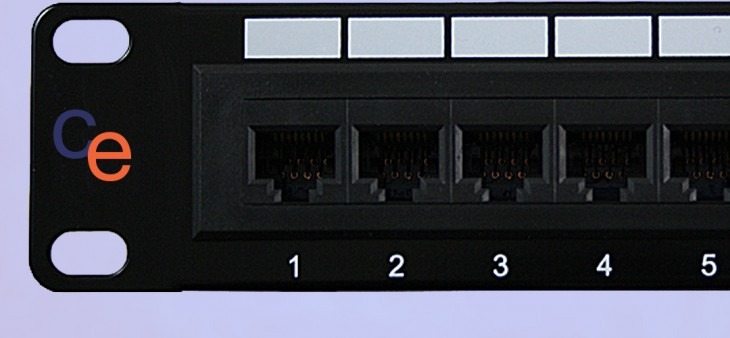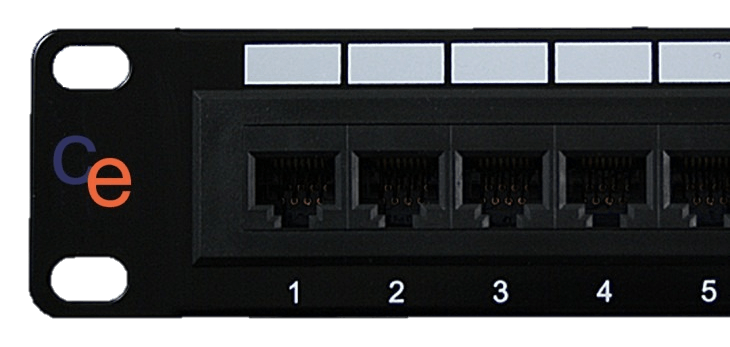

In today’s interconnected world, efficient network cabling is crucial for seamless communication and data transfer. A key component in structured cabling systems is the patch panel. Whether you’re setting up a data center or enhancing your LAN setup, understanding the role of patch panels can significantly improve your network’s performance and organisation. This guide will delve into the types, benefits, and applications of patch panels, helping you make informed decisions for your network infrastructure.
What are patch panels?
Patch panels, also known as patch fields or patch bays, are a piece of hardware containing multiple ports. Each port on the panel, through the use of a cable, will connect to a port located in a separate location, such as a server or a network switch. They are mostly used as an organizational solution, but also work great as a management system to keep future maintenance quick and easy. They come in all different sizes to fit each situation’s panel needs, although the most common are 12 port, 24 port, and 48 port panels.
What Are The Benefits?
One of the main benefits of a patch panel is the reduction of clutter it brings. From being able to use shorter cables to reach your equipment to having everything neatly organised, patch panels arrange your cables in a way to best utilize the space available and avoids tangled wires in the future.
During the initial setup and organisational process, each port can be labelled to make identifying connected devices easier in the future. This is particularly useful when troubleshooting problems, or moving or changing wires. Patch panels make future maintenance or cable changes a breeze, eliminating the need to re-run the entire length of cable back to its final destination.
What’s more, patch panels can even save you money in the long run. Whilst being an extremely useful and beneficial product, they aren’t considered a ‘smart’ device and are therefore inexpensive to buy and maintain. Once installed, you will be able to further save on cables with the ability to use shorter, and often less expensive, wiring options. Frequent movement of Ethernet cables can result in connectivity loss, or at worst cable failure, so being able to keep these cables safely at the back of the patch panel can protect them and avoid need for replacement.
How do they work?
Patch panels work by connecting cables through its RJ45 connectors and IDC terminal blocks to reach from one port to the next. Network and Ethernet cables will be connected to the back of the panel using the IDC termination blocks to reroute their signals to their new intended destination. This will then be linked to the RJ45 connectors at the front of the panel, which will then connect to its intended device through a patch cable.
Patch panels work best in a central location, such as a server room or a data center, remaining close to the user-end equipment. This central location allows shorter cables to be used at the front end of the patch panels saving money on cabling overall.
The most common use for patch panels are within organisations’ local area network (LAN) to connect computers to each other, or to the internet. The LAN may then be further connected to a Wider Area Network (WAN).
Types of Panels
The most common types of patch panels are twisted pair copper, fiber optic, and coaxial. Twister pair copper panels and fiber optic panels are typically seen in local area networks, whereas coax panels are mostly seen in audio/visual installations.
• Twisted Pair Copper – These panels are built to a certain Ethernet specifications such as Cat 5e, Cat 6, and Cat 6a.
• Fiber Optics – These panels support optical fiber connections like lucent connector (LC), subscriber connector (SC), and straight tip connectors (ST).
• Coaxial – These panels usually connect TVs, media layers, and cameras.
CE Patch Panels
Available for Cat5e and Cat6

CE RJ45 Patch Panels in various port densities and configurations, including IDC punch down and through coupler option.
All patch panels are 19-inch rackmountable and come with rackmount cage nuts and bolts for fixing to the cabinet. All CE patch panels comply with the latest standards required.
In conclusion, if you’re responsible for a wired network, a patch panel can be highly beneficial for cable management and seamless network routing. A suitable patch panel for your network will work with your existing components to help you to create a more adaptable and scalable cabling infrastructure for your business.
This is just a brief look at the CE Patch Panel Range, if you require more Patch Panels for your business, you can check our Patch Panel category for a wide range of patch panels to suit your needs.
More Patch Panels Available from Comms Express:
Fibre Patch Panels | Cat6 Patch Panels | Cat5e Patch Panels | D Series Patch Panels | Cat6A Patch Panels | Dynamode Patch Panels | Keystone Jack Patch Panel Cat6a, Cat6, Cat5e | Cable Tidy Solutions
If you require any further information on these or any other products that we stock here at Comms Express, please do not hesitate to contact our team who will be only too happy to help.
Until next time…
